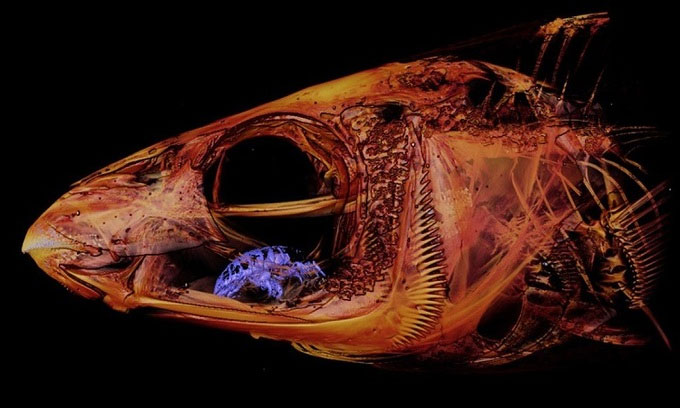Detecting parasitic tongue-eating lice in fish's mouth
There are many terrifying parasites on our planet, but few can match the level of horror that the flatfoot beetle, or tongue lice (Cymothoa exigua) can bring.
This organism enters the fish through the gills, clinging to them until adulthood. At this time, they will change sex from male to female.
Once this process is complete, the parasites begin to find their way to the fish's mouth. Here, it clings to the fish's tongue with sharp spikes on its legs, and begins to suck blood "crazy".
After a while, the fish's blood vessels in this area cannot meet the demand from the parasites. Eventually, the fish's tongue will become anemic, leading to necrosis and loss.
At this point, a terrifying process will take place, when the tongue-eating louse becomes a "substitute" for the fish's tongue, like a prosthetic. It is known that Cymothoa exigua is the only organism on Earth that can replace an entire host's organs without causing the host to die in the process.

Flat-footed beetles (blue) in the mouth cavity of the halibut.
There are about 380 species of foot beetles that all eat tongues and most target a particular type of fish. They enter the fish through the gills, attach to the tongue and secrete anticoagulant to keep the blood flowing. They cling to the base of the tongue with seven pairs of legs, reducing the blood supply causing the organ to eventually atrophy and fall off, according to the Australian Museum.
After that, the foot beetle's body all acts like a normal tongue while continuing to suck mucus from the fish. The symbiotic relationship between fish and foot beetles lasts for years. In many cases, the fish even outlived the parasite, says Stefanie Kaiser, a postdoctoral fellow at the Institute for Water and Atmospheric Research in Wellington, New Zealand.
Biologist Kory Evans, an associate professor at Rice University in Houston, Texas, came across the fish and its live tongue as part of a tomography project of a family of reef sharks. The goal of the project is to create a 3D radiological database of the bones of this fish family to make available to researchers around the world.
"That morning, I compared the skulls of different fish and had to put digital markers on the body parts. When I examined the fish with the scientific name Odax cyanomelas in New Zealand, I I noticed something strange in my mouth. It looked like some kind of insect. Then I thought that this fish eats seaweed. So I looked at the photo again and discovered that the louse eats the tongue." Evans recounted.
- The cure for pubic lice is simple and cheap
- Blood sucking creatures appear in tuna boxes
- Lice debris removal within a day
- Do not confuse tongue cancer and mouth heat
- The unbelievable thing about the cat's tongue made many people terrified
- Pandemic hair is about to explode when 98% of lice are resistant
- Hummingbirds suck bile with their tongue
- Appeared monsters specializing in eating the victim's tongue
- Ancient lice trapped in amber 100 million years
- How to prevent pubic lice - Insects cling to 'closed areas'
- Unique tongue uses of animals
- Dinosaurs must also taste suffering because of ... lice
 Animal 'suffering' after hibernation
Animal 'suffering' after hibernation Why do goats climb well?
Why do goats climb well? Scientists were surprised to see chimpanzees eating turtles
Scientists were surprised to see chimpanzees eating turtles Giant catfish died deadly due to drought in Thailand
Giant catfish died deadly due to drought in Thailand